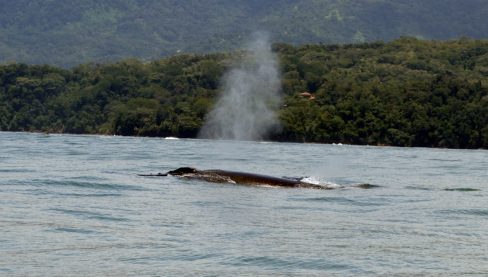
Now is the time to head down to warm waters of the Golfo Dulce in southern Costa Rica. Pacific humpback whales arrive on their annual migration to mate and socialize. After spending the southern summer in Antarctica, they head to the tropics the breed. They stay until October. You will get up-close to giant sentient beings that share the planet with us. These southern whales hang-out in the protected waters of the Golfo Dulce and the Ballena National Marine Park. Here they enjoy shallow coastal waters and protection from natural predators like sharks and Orcas. National Geographic rated Costa Rica the 7th best place in the world for whale watching. Watch their tail-slapping displays, breaches above the water and spot their distinctive humps.
“I remember vividly the first time I saw a humpback whale in the wild. Suddenly, a spray of water erupted from the calm blue-green water a few hundred yards off the beach. The long, black and barnacled form of a mother humpback whale surfaced gracefully for air. Our little group pointed excitedly at the huge whale. Then we gasped in delight as we caught sight of the smaller shape of her baby swimming by her side.
We jumped into a boat, and at a respectful distance, we cruised along with mother and baby as they slowly swam along the dark green coast thick with rainforest. Pairs of Scarlet Macaws flew overhead as sunset neared, heading to roost in tall shoreline trees for the night. The whales disappeared out of sight, and we motored back enchanted.” Shannon Farley.
If seeing whales and dolphins up close in their natural environment is on your bucket list, you can go on Costa Rica whale-watching tours from Playa Nicuesa Rainforest Lodge starting toward the end of July through the end of September. Keep a look-out also for visiting whale sharks, the largest fish in the sea. Nicuesa Lodge is giving a special offer of one free night when you stay a minimum of three or more nights. Contact us for more details.
RELATED: 12 amazing things to do in Costa Rica

